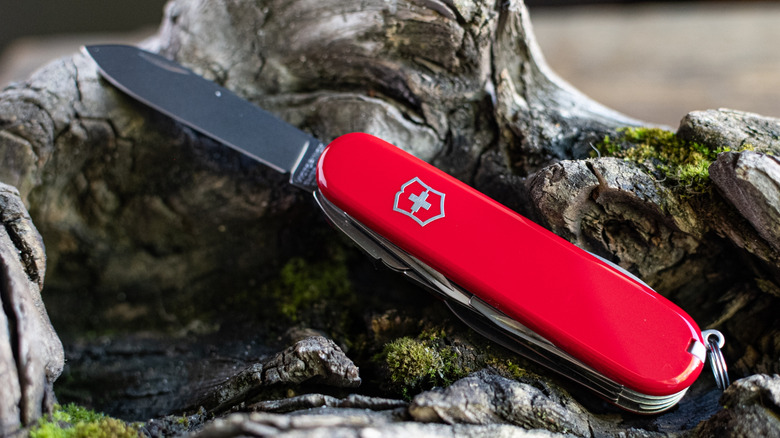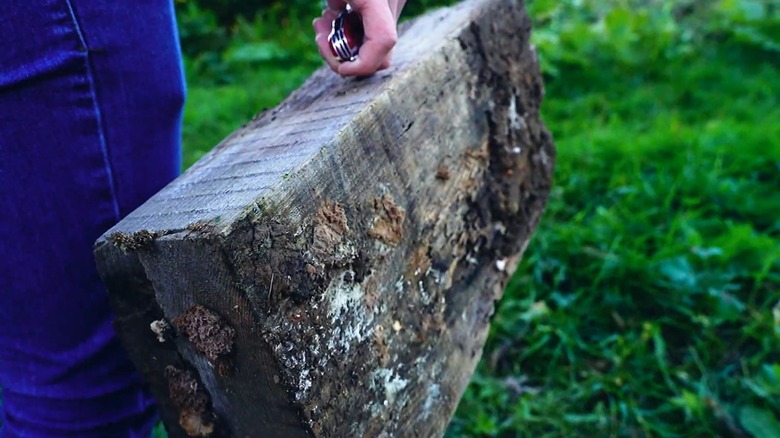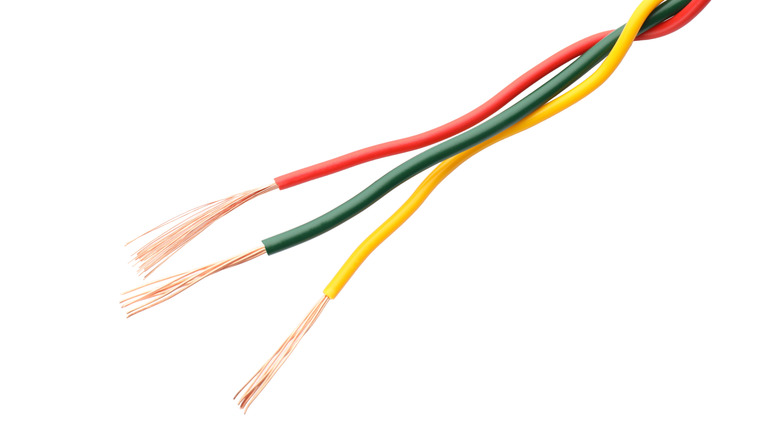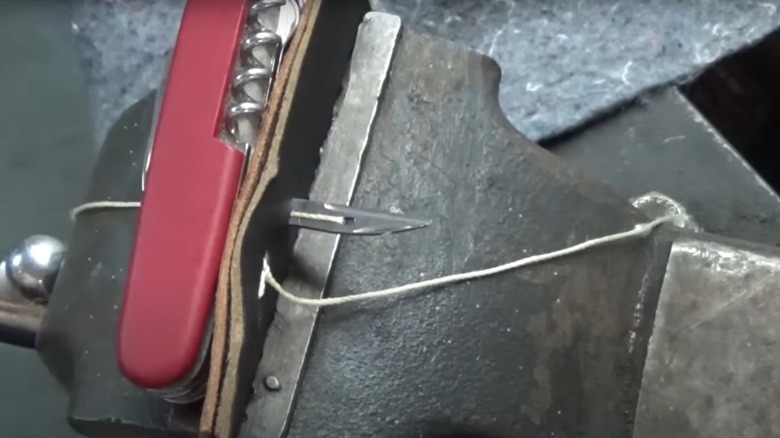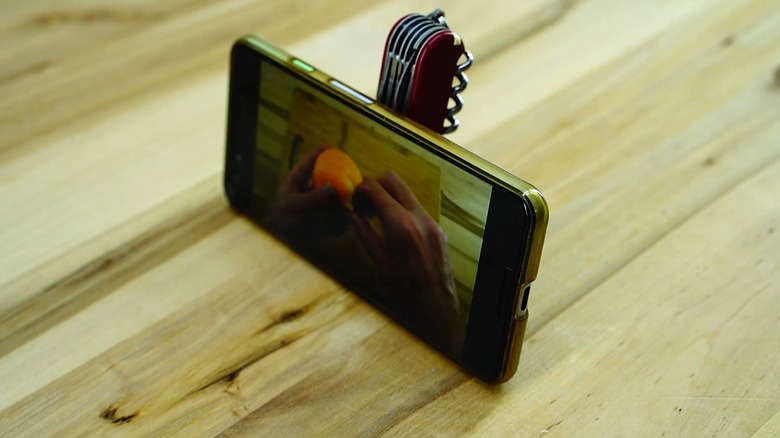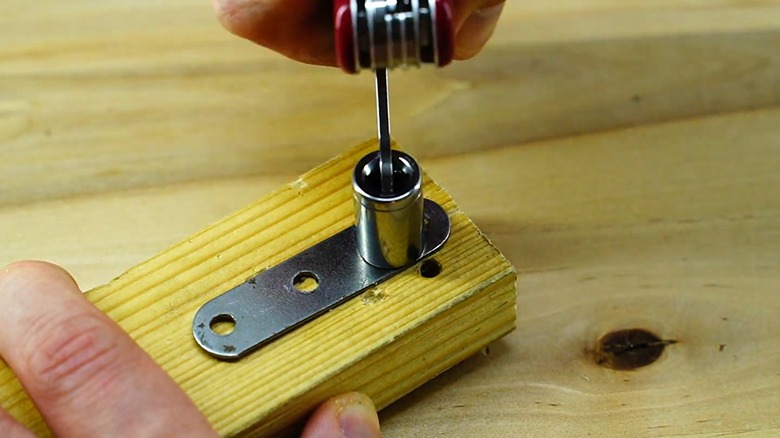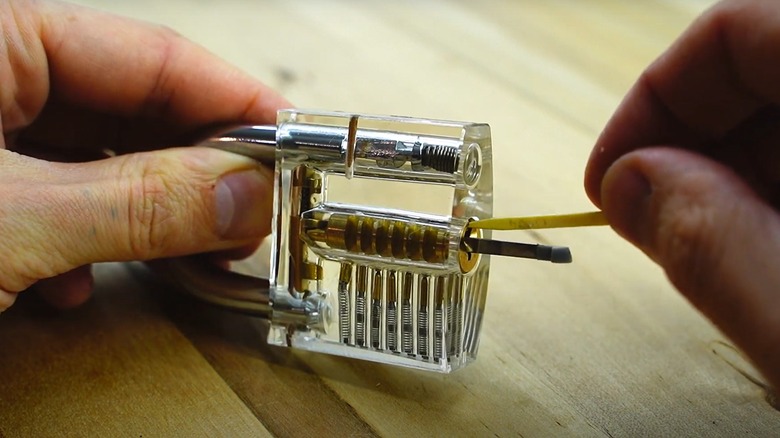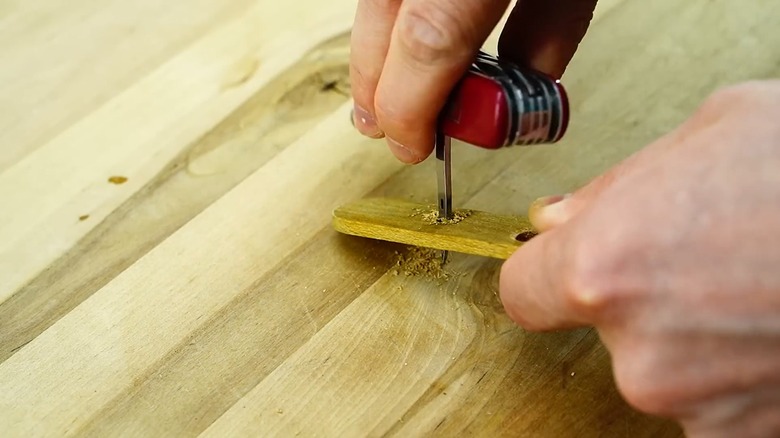10 Alternative Uses For Swiss Army Knife Tools You May Have Never Thought Of Before
The Swiss Army Knife is the de facto multitool. Need a knife and tweezers? It's got you covered. What about a saw and a bottle opener? Those are tucked inside the same pocket-sized case too. While some Swiss Army Knives have more tools than others, they all manage to pack a surprising number of small and useful tools into a compact form. However, the number of things you can do with it isn't limited to the hardware it includes.
While we humans are skilled in the invention of new tools — and we have invented a LOT — we are equally proficient in the art of producing new uses for existing items. For instance, a Leatherman Multitool's file can be used for deburring, starting fires, and trimming fingernails. With enough creativity, you can come up with your own alternative uses for the Swiss Army Knife and its myriad of instruments. Or you could just read this article and learn about all the makeshift utilizations other people have invented. You'd be surprised how many uses a corkscrew has other than just removing a cork from a wine bottle.
Here are 10 creative uses for the Swiss Army Knife that you probably never thought of.
Corkscrew carry handle
A Swiss Army Knife's shell plays double duty as a handle. Whenever you unsheathe a tool, the body provides some leverage. It's not a lot, but it's usually enough, especially since items like the corkscrew rely on a solid grip and a quick jerk. But the corkscrew has more uses than just letting you sip a fine wine.
When you flip out the corkscrew, you might notice it's oriented perpendicular to the main body instead of parallel. This setup makes it easier to twist into corks, as well as other pliable woods. You can screw it into a small log, and it'll grip the interior enough that you can carry the log like luggage by using the knife's body as a handle. You can alternatively wrap a log with twine or string, thread it through the corkscrew, and carry it the same way. The same trick also works with plastic bags to give your fingers a firmer grip. Just keep in mind that because of how most Swiss Army Knives are built, this hack only supports about 30 lbs.
Since this technique relies on a corkscrew, it only works with a limited number of models. These include the Swiss Champ, Huntsman, Spartan, and Ranger, among others. Moreover, the closer the corkscrew's pivot point is to the middle of the Swiss Army Knife, the better. Knives such as the Wine Master Wood have a significantly offset corkscrew pivot point, which makes it ill-equipped for the task.
Wire stripper
Many alternate uses for Swiss Army Knife implements only utilize one tool. However, some more advanced techniques require Swiss Army Knife items working in tandem, especially when securing something is crucial.
One little-known feature in many Swiss Army Knives is the ability to strip a wire. It's not a true "alternate use," but most people don't know about the wire stripper because the tool — a tiny notch — is built into the bottle opener. First, you have to unfold the bottle opener/wire stripping tool and the knife. Next, secure a wire under the bottle opener/wire stripper. Then, snap the knife down to start cutting through the wire's sheath. Twist the wire so the knife cuts through all around the covering. Finally, snuggle the wire into the stripping notch and give it a yank.
While you can cut through a wire's sheath with any Swiss Army Knife's titular knife (or any knife for that matter), not all models include a bottle opener with the notch crucial for stripping. The Swiss Champ, Huntsman, Spartan, and Ranger all have the necessary equipment. However, to strip the wire as described above, the knife and bottle opener/wire stripper need to sit on opposite ends of the Swiss Army Knife. The Ranger 55 Grip Onyx places both tools on the same side, so while you can secure the wire with the can opener, you'll need to flip out the bottle opener and retract all the other tools to carry out the final step.
Pole saw
If you need to saw off a tree branch, you can either lug a saw up a ladder or use a pole saw. While pole saws are the safer option — as long as you take measures to ensure the branch doesn't fall on your head — they can be expensive. However, you can save some money by turning a Swiss Army Knife into a makeshift pole saw.
To transform a Swiss Army Knife into a pole saw, you'll need a model with a saw (duh), a can opener, a long wooden pole or branch, and a thin bungee cord or something similar. Start by drilling a hole into the wood with a tool like the corkscrew. Once the Swiss Army Knife is flush against the rod or branch, unfold the saw and the can opener on opposite sides. Then, strap the multitool to the rod with the bungee cord, looping it through the can opener's opening. Once the attachment is tight, you can start pruning a tree.
This trick relies on three different tools working in tandem — a saw, a tool to drill a hole in wood, and a can opener. The Swiss Champ, Huntsman, and Ranger fit the bill because they have all three. Tools like the Rescue Tool MW may have the saw and drilling implements, but without the can opener, strapping this multitool to a wooden rod won't produce a secure fit, if any.
DIY leather sewing kit
Admittedly, several "alternative uses" for Swiss Army Knife tools stem from the fact that we have absolutely no idea what some of them are. For instance, did you know that a Swiss Army Knife has an awl? No, this is not a misspelling of the word "owl," but an actual tool.
First off, what is an awl? It's the small knife-like tool on a Swiss Army Knife you can use to sew two leather pieces together. You start by stringing twine or some other binding material through the awl's hole. Then you puncture the leather pieces — make sure to go all the way through. Slightly pull the awl out so the twine forms a loop. Grab the loop so the twine comes out of the freshly punctured leather, and then pull the awl out the rest of the way. Skewer the leather again with the awl to form another slot, and pull it back enough to create another loop in the twine. Thread the twine from the first puncture through the loop, remove the awl, and repeat the process. If you want to make the process easier, you can score where you plan on puncturing the leather with the awl itself.
Plenty of Swiss Army Knives have the awl necessary for sewing up leather, including the Swiss Champ, Ranger, Huntsman, Spartan, and Deluxe Tinker. However, multitools like the Outrider and Work Champ XL have holeless awls, so while they can skewer leather scraps, they are useless for sewing.
Cell phone stand
Cell phones are as essential to DIY work as Swiss Army Knives. While the Swiss Army Knife provides a gaggle of tools, cell phones let you look up instructions and video guides on the fly. Even if a job sits outside the purview of a Swiss Army Knife's capabilities, you can use it to prop up your phone.
If you don't want to shell out the money for a quirky and unique phone stand – or don't want to bring it with you — you can use a Swiss Army Knife as a makeshift stand. All you have to do is angle one tool to prop up the main body on a flat surface. You can use the scissors, the parcel hook, or many other tools. Of course, you have to make sure that the Swiss Army Knife's angle is stable.
Since virtually any tool in the Swiss Army Knife's utility belt can turn the multitool into a cell phone stand, this secret use is compatible with more models than most. These include the Swiss Champ, Huntsman, and Ranger. However, a Swiss Army Knife has to support a phone's weight, so smaller models such as the Classic SD are ill-suited to the task. Moreover, to remain as stable as possible, a phone must stay flush against the central body. Knives with curved bodies like the Work Champ and Skipper Pro should be avoided.
Screwdriver of all sizes
While a Swiss Army Knife's small size is its biggest strength, it's also the multitool's biggest weakness. How Victorinox can fit so many disparate tools into a tiny frame is nothing short of a miracle, but that leaves little room for similar tools of slightly varying sizes. But you can still use other tools to fill the gaps in functionality.
Many Swiss Army Knives have built-in screwdrivers. The tips of the can and bottle opener, for instance, are designed to double as flatheads, and some models even have a Phillips-head bit. However, these screwdrivers aren't universal, so sometimes you have to use tools in unorthodox ways. The file's head and the scissor spring are so thin they can unscrew tiny screws. You can also angle a parcel hook to fit and twist hexagon nut hex sockets. This lets you secure and remove hex nuts and also use screwdriver heads that fit the socket. And if you have a dome-headed screw you don't mind defacing, you can use the metal file to shave a new drive and then use one of the aforementioned flatheads to get it out. This technique is ideal if you need to remove a stripped screw.
Understandably, the aforementioned hacks rely on Swiss Army Knives having the appropriate tools. For instance, models such as the Swiss Champ and Ranger have the files and scissors that can be used to fit the tiniest of screws. Meanwhile, models with a parcel hook, including the Deluxe Tinker and Climber, can take advantage of the parcel hook hex head trick.
Lockpick
While we do not condone picking locks to break into someone else's house, general knowledge of how to pick locks can have its uses. However, knowing how to pick a lock is pointless if you don't have the tools. While plenty of stores and companies offer lockpick kits, you can jury-rig your own with the right Swiss Army Knife.
To pick a lock with a Swiss Army Knife, you need only the multitool's tweezers and toothpick. The tweezers act as a tension tool and are inserted into the top of the lock's hole — where the key's teeth move the tumblers. Meanwhile, the toothpick is slotted on top of the tweezers and helps force the lock open when you twist both tools. There is a science to lockpicking that goes beyond mere words, so you need to get a figurative and literal feel for the procedure. And of course, these techniques will only work on locks that utilize physical keys; smart locks are immune.
So long as your Swiss Army Knife has both small tweezers and a toothpick, you can use them to open locks. The Swiss Champ and Huntsman have these tools, but you can go as inexpensive as the Classic SD or even the Escort and still have everything you need. However, some models, such as the prohibitively expensive Classic with Gold Ingot, are useless since they have tweezers but no toothpick, whereas models with wooden handles, including the Spartan Wood, are missing both the tweezers and toothpick.
Firestarter
The Swiss Army Knife is handy in both a workplace and camping setting. If you need to screw something in, you can often use a Swiss Army Knife, and if you need to cut up some thin branches to start a fire, many models come with a saw for just such an occasion. But if you actually need to start a campfire and don't have the proper tools, a Swiss Army Knife can work in a pinch.
After you've gathered enough tinder to start a fire, you only need something to ignite it. If it's light out, you can use the magnifying glass trick and focus the sun's rays into lighting the fire. Just flip out the multitool's magnifying glass and tweak its position until the tinder starts smoking. You'll also need to blow on the heated material to get a flame really going. If you don't have a magnifying glass, you can create a spark by striking any Swiss Army Knife tool against a Firesteel rod or any other ferro rod. While the sharp edge of a knife works best, you can quickly dull the blade with this hack — so you're better off using the blunt edge of the saw or file.
To start a fire with a magnifying glass, you need the Swiss Champ or Explorer – even the Pocket Knife Toy could potentially serve this purpose. However, if you go the ferro rod route, virtually any Swiss Army Knife will work, but models with saws and files, including the Swiss Champ and Ranger, will last the longest.
Hole driller
Swiss Army Knives have almost every conceivable construction and repair tool you'll ever need — except for a drill. Sure, a corkscrew is designed to bore into materials, but it can't make the type of hole you associate with drills. But you don't need a cordless drill to punch holes into wood.
To make a hole in a piece of wood, all you need is a Swiss Army Knife with an awl. Just puncture the material and start twisting the awl around until it punches through the other side. At its widest, the awl can make a 6 mm hole, but if that's not big enough, you can widen the hole using the multitool's miniature saw. Insert the saw into the hole and start twisting it as you did with the awl. The saw's teeth should grind away at the material, and if you use the tool's entire length, you'll end up with a 10 mm hole.
So long as a Swiss Army Knife has an awl, you can start making holes in wood. The Swiss Champ and the Huntsman are the whole package since they include both an awl and a saw, but if you only need a small hole, you can get away with just the awl on a Spartan or Deluxe Tinker. Unlike the sewing trick, you don't even need an awl with a hole, which means you can use models like the Outrider to drill into wood. However, since you need an awl to start the process more easily, Swiss Army Knives that have a saw but no awl, such as the Hunter XT Grip or Swiss Army 7 Alox, are less ideal for the task.
Nut opener
How do you open nuts to get at the snack within? Most people use a nutcracker, which usually works, but then the shells get everywhere. Picking shell splinters out of the carpet and couch cushions is super annoying, but there are easier alternatives if you have a small and thin enough tool.
While the flathead screwdrivers of a Swiss Army Knife aren't intended for this, you can use them to easily eat peanuts and walnuts. Let's say you want to open a walnut. All you have to do is flip up a bottle opener or can opener, slot the tool into the walnut's natural crack, and keep working it in until the can or bottle opener's widening width forces the seed open. The same trick works with a peanut, but depending on where you insert the tool, you might have to pry it open, sort of like how you use a crowbar.
Since this trick relies on the design of a Swiss Army Knife's bottle or can opener, any model that carries one will work. And since so many Swiss Army Knives come with at least one of these tools, it would quite frankly be easier to list the ones that don't. So long as you don't own a Classic SD, Nail Clip 580, Classic with Gold Ingot, Rambler, or Mini Champ, you can use your multitool to crack open a quick nutty snack.
